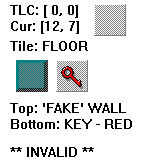Please create an account or Login! Have fun!
Invalid tile: Difference between revisions
imported>Random 8 (lots of stuff (btw there's an unfinished sentence in the last paragraph and idk what's meant to go there)) |
(No difference)
|
Revision as of 10:53, 2 August 2017
An invalid tile is any tile that doesn't exist in, or any tile combination that is impossible in, the original Atari Lynx version of Chip's Challenge. In Lynx, every square consists of an object (non-monster) and 0 or 1 monsters, including blocks and Chip. In MS, a space is just something on top and something on bottom--even normal floor is actually a floor tile on a floor tile. MS also allows internal use tiles, like Burned Chip and Swimming Chip, to be placed as if they are actual game elements. Any tile or tile combination that can be placed in MS but not Lynx is considered invalid.
Tile World's Lynx generally does not allow play in levels with invalid tiles. Invalid tiles are present in CCLP2 and many custom level sets, and a combination is distinguished in ChipEdit using the following:
Single tiles
Fake exits, Burned Chips, Swimming Chips, Drowned Chips and the unused tiles were not seen as a tile themselves in CC1, and hence are not recognized by the original Lynx version. However, Tile World's Lynx mode allows the Swimming Chip to remain as is, turns the fake exit into a real exit in Tile World versions prior to 1.3, and turns the four other tiles or all five into walls depending on the version.
North and west thin walls are never seen in CC1, and therefore are also not recognized by the original Lynx version. However, they are generally not considered invalid, and Tile World's Lynx allows them as is unless the program is run in pedantic mode.
Transparency
Chip and monsters are both transparent, meaning it was intended for other tiles to go underneath them. Every tile can be buried underneath monsters and Chip, with the exception of other monsters and another Chip. Keys and boots are transparent, but cannot have any tiles buried underneath them, and it is unknown why these tiles were made transparent in the first place.
All non-transparent tiles, such as computer chips, water, locks, and even floor, will not allow tiles to be buried underneath them. The only exception is blocks, which can conceal any tile but Chip, monsters, clone blocks, and another block.
Preventing use of invalid tiles
Since invalid tiles make a level unplayable in Lynx, their use is discouraged. In ChipEdit, hovering your mouse over any location will tell if the combination is invalid or not by showing **INVALID** in the top-right corner. There is also an option called Check which does not allow the placement of invalid tiles when designing a level. The latest version of CCEdit has a similar feature: it shows a small red triangle in the corner of a tile if it is invalid. The other two editors do not have this option, so the placement of invalid tiles is up to the discretion of the designer.
Fortunately, Tile World exports the locations of invalid tiles to a file called stderr.txt, which allows the user to easily pinpoint the invalid tiles.
Use in CCLPs
Since there are no invalid tiles present in CC1, CCLP2 contained the first official use of invalid tiles. They were first seen in The Parallel Port, and are present in 50 of the 149 levels - each of which is in . CCLP3 is Lynx-compatible, and thus does not contain any invalid tiles. CCLP1 and CCLP4 do not use invalid tiles either, since they are also Lynx-compatible.
